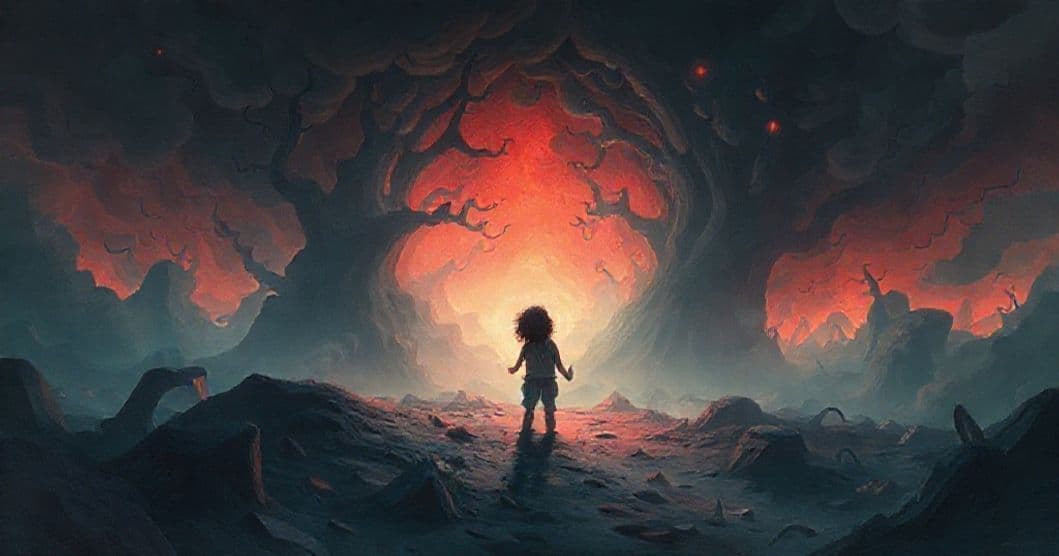Part 1: Dream Presentation
Dreams often arrive unannounced, carrying symbolic messages from our deeper consciousness. Consider this vivid dream experience: a child’s vision of hell, a red-skinned devil, and a language that spoke volumes without words. In the recesses of my earliest memories, there exists a dream so vivid it feels almost like a second life—a vision from a time when I was but two years old, yet old enough to feel terror with the clarity of an adult. I remember floating, though I had no concept of floating, in a world that burned with an unholy light. The air was thick with the acrid stench of something I couldn’t yet name, and my tiny body was wracked with sobs I couldn’t control. I was crying, not just tears but a primal wailing that tore from my throat without conscious thought. In front of me stood a figure so imposing it shattered the boundaries of my young mind: a being I would later learn to call the devil, though at the time I knew only fear. He was tall, impossibly so, his frame muscular and rippling with strength beneath a skin the color of fresh blood. From his temples protruded long, curved horns that glinted in the hellish light, and his eyes burned like embers. In his right hand, he held a trident, its prongs red as the flames surrounding us, and his voice—a voice like gravel grinding against stone—resounded in my ears. But what I remember most acutely is the language he spoke: not English, not any language I’d ever heard. It was a language of his own, a tongue that felt both familiar and utterly foreign, a sound that wrapped around me like a serpent and left me with an inescapable sense of dread. I couldn’t understand a word, yet I understood its meaning perfectly: danger, judgment, the weight of something I’d done wrong. The background was a landscape of perpetual fire—flames licking at invisible skies, smoke curling into the air, and the ground beneath us (though we were floating) cracked and broken. Despite my terror, there was a strange clarity to the dream: I knew this place, or at least I knew it should be known to me. Now, decades later, I’ve revisited this memory and found new meaning. I’ve begun to wonder if perhaps this was not just a dream but a vision of a past life—a time when I died and faced the consequences of my actions, only to be given a second chance. I see now how the places I’ve visited in waking life sometimes feel eerily familiar, like echoes of that hellish landscape, and how certain people seem to carry the same weight of judgment I felt from that red-skinned figure. It’s a paradox, really: I’m not religious, yet this dream has become a lens through which I view my present life, searching for signs of both sin and salvation in the mundane details of each day.
Part 2: Clinical Analysis
Symbolic Landscape: The Child’s Unconscious and the Devil Archetype
Want a More Personalized Interpretation?
Get your own AI-powered dream analysis tailored specifically to your dream
🔮Try Dream Analysis FreeThe devil figure in this dream is a powerful archetype that transcends religious boundaries, representing the shadow self—the parts of ourselves we fear, deny, or project onto external forces. In Jungian psychology, the devil often symbolizes repressed anger, moral conflicts, or the fear of judgment. For a two-year-old, this figure embodies the child’s earliest understanding of danger and punishment. The red color of the devil’s skin is particularly significant: red traditionally signifies passion, danger, and intensity in dream symbolism. In this context, it may represent the child’s overwhelming emotional state—rage, fear, or confusion—projected onto a single, terrifying entity. The trident, a weapon of authority and judgment, reinforces themes of accountability and retribution. The language barrier is equally symbolic: it represents the child’s inability to articulate complex emotions or understand abstract concepts like sin or morality, forcing the dreamer to experience fear without cognitive explanation.
The hellish landscape, with its burning flames and cracked earth, serves as a metaphor for internal turmoil. In dreams, fire often symbolizes transformation, but here it manifests as destruction—a representation of the child’s sense of being consumed by something beyond control. The act of floating suggests detachment from reality, a common dream theme indicating the dreamer’s feeling of being outside their own body or circumstances. The child’s crying, though primal, is a cry for help—a plea for understanding or release from the overwhelming fear.
Psychological Perspectives: Unpacking the Layers of Childhood Dreams
From a Freudian perspective, this dream may reflect repressed memories or unresolved conflicts from early childhood. The devil figure could represent the superego—the internalized moral voice that judges the child’s behavior. The language barrier might symbolize the child’s struggle to reconcile instinctual desires with societal expectations, resulting in anxiety that manifests as a hellish vision. However, Freud’s focus on sexual and aggressive drives may not fully capture the child’s experience, as a two-year-old’s psychological development is more about identity formation than complex sexuality.
Jung’s analytical psychology offers a richer framework here, emphasizing the collective unconscious and archetypal patterns. The devil is not merely a demon but a manifestation of the shadow—the parts of the psyche we reject. For a child, this shadow could represent the fear of the unknown, the fear of parental rejection, or the fear of failing to meet societal expectations. The second chance narrative, which the dreamer now attributes to
